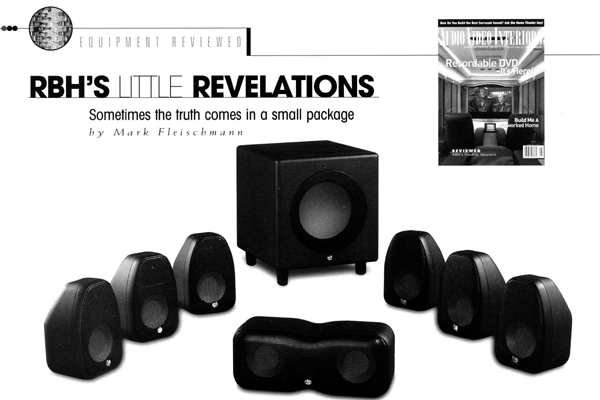This article appeared in the May 2002 issue of Audio Video Interiors

Sometimes the truth comes in a small package
by Mark Fleischmann

Let's see. The "small wonders" headline has already been used a thousand times. I may have been guilty of the first few hundred uses. And I'm not going to tell you that the small wonders reviewed here, RBH's CT-5 satellites and MS-8.1 sub-woofer, provide powered-tower slam in a compact package. The laws of physics have their limits and that would be wishful thinking at best. But I can tell you that George Harrison's untimely death moved me to pull his monumental All Things Must Pass off the shelf. This RBH speaker system proceeded to peel Phil Spector's multi-layered production like an onion—lovingly documenting each layer, from Harrison's vocal harmonies to Eric Clapton's omnipresent wailing guitars. Though Iran through the same music with a few other speakers that I know and love, it was the RBH's that produced the most coherent—and, yes, moving—results.
Say hi to a quartet of seven-inch-tall two-way
MM-4 satellites, each with a one-inch silk dome tweeter and four-inch
aluminum woofer. These drivers, and the gold-nut binding posts in back,
are not exactly the cheapest parts that a sat/sub manufacturer might
choose to use. They come in a rounded non-rectangular die cast aluminum
enclosure that emits a well-deadened thunk when knuckle-rapped. The C-4
center speaker uses the familiar woofer/tweeter/woofer configuration.
Inside the sub are two eight-inch drivers, facing forward and downward,
and a 200-watt amplifier. Sensitivity is on the low side at 85dB for the
sats and 88dB for the center—these satellites want lots of clean power.
The sub includes a high-pass filter of 100 Hz for the speaker-level
outputs only, line-level inputs can be adjusted between 40 and 160
Hertz. The 5.1-channel package costs $1099. If you prefer your surround
in 7.1-channel surround, the similar CT-7 contains the extra pair of
satellites for $1349. Utah-based RBH provides a five-year warranty on
everything except the sub amp. The system is available in black or
white.
In this month's review system was the Arcam AVR200 receiver already
reviewed in the February issue. (The U.S. version of this product will
be shipping with an improved backlit remote for $1199.) The speakers
were well satisfied with its 70 watts times five. Other listening
companions included the JVC XV-FA95GD ($499.95), a carousel changer that
plays DVD-Video, DVDAudio, Compact Discs, and MP3 files burned onto
CD-R, among other things.
Of course, not too many people play either musty old George Harrison
LPs or DVD-Audio discs. But lots of us play CDs. The RBH's, the
seven-disc JVC changer, and seven new CDs all just happened to arrive in
my review studio at virtually the same moment. You can guess what
happened next: I loaded up the changer with the new June Tabor album
Rosa Mundi and three two-disc sets of classical and rock music and let
it fly. The Tabor CD—a celebration of the rose dominated by a strong
group of traditionally derived songs—provided ample opportunity for the
RBH's to stumble. But the speakers did a surprisingly good job of
conveying the subtle dynamics of the recording and vast inky black
spaces between the English singer's melancholy vocal sonorities and the
spartan piano, viola, and cello that accompanied her.
The weirdest thing I listened to was the two-CD repackaging of Bach
Hits Back and A Cappella Amadeus by the Swingle Singers. At the sound of
this name, people who don't quite remember the I 960s stir and look
slightly perplexed. People who do remember the I 960s start grinning.
The Swingles became a camp sensation with astonishingly disciplined
eight-part scat singing of familiar tunes by Bach. RBH's satellites and
subwoofer shrewdly navigated the jazzy sonic sculptures on these two
10-year-old releases. Such vocally dominated music is actually quite
hard to reproduce perfectly as sopranos, altos, tenors, and basses race
up and down scales, from one end of the frequency spectrum to the other.
One swollen note would ruin the whole cascade. But that note never
came.
Only when the Swingle basses reached down into their bottom octave did
the system betray an audible quirk—not in tonal balance, but imaging.
The lowest notes would jump right into the sub where I could localize
them easily. The same effect was audible on Nick Drake's Pink Moon
whenever Drake's voice hit a percussive consonant. It was certainly not a
problem with, say, the bass line in the opening theme of The Sopranos,
which came through in all its ominous testosterone-fired glory, but it
was mildly disconcerting with music dominated by resonant male voices.
With the volume just one-third up, the sub level wasn't excessively
high, so the cause must have been the relatively high crossover point of
100 Hz between sats and sub (versus, say, the more common 80 Hz
recommended by THX). Satellites with four-inch woofers tend not to have
full-range bass response. Therefore the sub had to fill in the mid- and
upper-bass. After a while I got used to this inevitable effect of
speaker miniaturization. There was never a moment when I put aside a CD
thinking: "No, the RBH's aren't up to this."
In fact, it's probably no accident that I reviewed the RBH CT-5 and
MS-8.1 with music that I actually listen to as opposed to relying on my
faithful, familiar test tracks. I got more day-today musical pleasure
out of these little revelations than I've gotten from any other
small-sat system. And there's no need for veiled warnings like "better
for movies than for music." This RBH speaker system handled everything I
threw at it and did so competently (quite often, brilliantly). These
satellites are out of this world.
Reprinted with permission from the May 2002 issue of Audio Video Interiors ® Copyright 2002, PRIMEDIA Inc. All rights reserved. For more information about reprints from Audio Video Interiors, contact Wright's Reprints at 877-652-5295